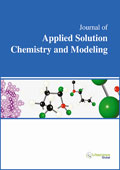jascm
Editor’s Choice : Nanostructures and Thermal Properties of the Binary Mixture of DNA and a Zwitterionic Phospholipid in the Bulk
|
|
Abstract: The mixtures of polyanionic DNA and zwitterionic phospholipids (ZL) have recently received much attention because of their potential for use as vectors in gene therapy or as a template for nanostructure construction. The past few studies on DNA-ZL system were carried out in their aqueous solutions and it was reported that a small fraction of DNA was capable of binding to zwitterionic lipids. However, it is still not known whether, as in the aqueous state, the DNA will be still intercalated between lipid bilayers in the bulk state. In the present study, we examined the DNA-ZL interactions in the bulk state by investigating a binary system composing of DNA and a zwitterionic lipid, 1,2-di(cis-9-octadecenoyl)-sn-glycero-3-phosphocholine (DOPC). The nanostructures and thermotropic phase behavior of this system were investigated using small angle X-ray scattering (SAXS) and differential scanning calorimeter (DSC), respectively. Our SAXS with one-dimensional correlation function results revealed that, as in the aqueous state, the DNA/DOPC bulk mixture forms a multilamellar phase, where the DNA was confined between the DOPC lipid bilayers. The thickness of the hydrophobic layers composed of lipids tails was greater in the DNA-DOPC mixture than in the pure DOPC. However, interestingly, the thickness of the hydrophilic layer composed of lipid headgroups in the DNA-DOPC mixture was same as in the pure DOPC even though in the former DNA was intercalated in this layer. Furthermore, according to the DSC endotherms we also observe that DNA induced a significant depression of gel-to-liquid crystalline phase transition temperature of DOPC bilayer. A thermodynamic model was presented that described the experimentally observed morphological and thermotropic phase behavior. Download Full Article |
Editor’s Choice : Entropy-Enthalpy Compensation and its Significance – in Particular for Nanoscale Events
|
|
Abstract: The basic thermodynamics behind the well-known, up to now hotly debated, notion of entropy-enthalpy compensation (EEC) is analyzed here in detail. Namely, any valid EEC phenomenon is considered using Carnot-cycle-type model, in which micro-phase transitions (MPTs) play a crucial role. Such MPTs could typically be some cooperative processes in (supra)molecular aggregates. Thus, the MPT notion ought to help rationalize the occurrence of the EEC in connection with some pertinent microscopic mechanisms. Download Full Article |
Editor’s Choice : Design, Characterization and Evaluation of Metallic Nano Biocomposites of Neomycin
|
|
Abstract: Neomycin is formulated into nanoparticles in order to increase the therapeutic efficacy, decrease the dose of drug and to decrease the topical dose related toxic effects. The present study was aimed at the preparation of zinc nanoparticles (ZN), chitosan nanoparticles (CN), zinc neomycin nanoparticles (ZNN) and zinc chitosan neomycin nanoparticles (ZCNN) in order to compare their antibacterial activity. Nanoparticles were prepared by subjecting the nano suspension containing the specified ingredients to stirring at 40оC for 4-5 h. The prepared nanoparticles were evaluated for particle size and surface morphology by Transmission Electron Microscopy (TEM), mean particle size and particle size distribution by DLS, percentage yield, loading efficiency, in vitro drug release by diffusion technique and agar cup plate method. TEM microphotographs and zeta sizer analysis revealed that the prepared nanoparticles were in the nanometric range, the particle size and particle size range of ZCNN was less compared to ZNN indicated more surface area of ZCNN. Among all the nanoparticles prepared, percentage yield, loading efficiency, in vitro drug release and zone of inhibition was found to be more for ZCNN. Thus, the results suggested that ZCNN act as promising drug delivery systems with better in vitro characteristics compared to other nanoparticles with increased therapeutic activity of neomycin. Download Full Article |
Editor’s Choice : Potentiometric and Thermodynamic Studies of Some Azosulfoxine Derivatives and Their Metal Complexes
|
|
Abstract: The proton-ligand dissociation constants of some azosulfoxine derivatives and metal-ligand stability constants of their complexes with the metal ions (Mn2+, Co2+, Ni2+ and Cu2+) have been determined potentiometrically in 0.1 MKCl and 50 % (by volume) DMF–water mixture at (298, 308 and 318) K. The stability constants of the formed complexes increases in the order Mn2+, Co2+, Ni2+ and Cu2+. The effect of temperature was studied and the corresponding thermodynamic parameters (∆G, ∆H and ∆S) were derived and discussed. The dissociation process is non-spontaneous, endothermic and entropically unfavourable. The formation of the metal complexes has been found to be spontaneous, endothermic and entropically favourable. Keywords: Azosulfoxines, potentiometry, stability constants and thermodynamics.Download Full Article |






















